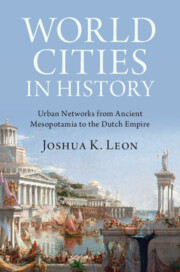Refine search
Actions for selected content:
252 results
1 - Building Social Mobility
-
- Book:
- Building Social Mobility
- Published online:
- 15 September 2025
- Print publication:
- 02 October 2025, pp 1-29
-
- Chapter
- Export citation
Debunking NIMBY Myths Increases Support for Affordable Housing, Especially Near Respondents’ Homes
-
- Journal:
- Journal of Experimental Political Science , First View
- Published online by Cambridge University Press:
- 09 September 2025, pp. 1-14
-
- Article
-
- You have access
- Open access
- HTML
- Export citation
Exploring Naturally Occurring Retirement Communities (NORCs) in the Context of the Social Determinants of Health
-
- Journal:
- Canadian Journal on Aging / La Revue canadienne du vieillissement , First View
- Published online by Cambridge University Press:
- 25 August 2025, pp. 1-7
-
- Article
-
- You have access
- Open access
- HTML
- Export citation
Small mammal owners’ experiences of housing challenges and animal welfare: A COM-B and word frequency analysis
-
- Journal:
- Animal Welfare / Volume 34 / 2025
- Published online by Cambridge University Press:
- 21 August 2025, e59
-
- Article
-
- You have access
- Open access
- HTML
- Export citation
9 - Housing Regulation
- from Part III - Regulation And Functional Law
-
- Book:
- Ending Income Inequality
- Published online:
- 09 June 2025
- Print publication:
- 26 June 2025, pp 233-260
-
- Chapter
- Export citation
A Haunting Legacy: Systemic Ableism in Canadian Housing Policy for People Labelled with Intellectual and Developmental Disabilities
-
- Journal:
- Canadian Journal of Political Science/Revue canadienne de science politique / Volume 58 / Issue 3 / September 2025
- Published online by Cambridge University Press:
- 13 June 2025, pp. 565-590
-
- Article
-
- You have access
- Open access
- HTML
- Export citation
22 - Scaling Down Senior Living
- from Part IV - The 100-Year Life and Our Broader Environment
-
-
- Book:
- Law and the 100-Year Life
- Published online:
- 13 May 2025
- Print publication:
- 29 May 2025, pp 296-308
-
- Chapter
-
- You have access
- Open access
- HTML
- Export citation
The Economic Origin of “Loyal Opposition”: Homeownership and Political Participation in China
-
- Journal:
- Journal of East Asian Studies / Volume 25 / Issue 1 / March 2025
- Published online by Cambridge University Press:
- 09 May 2025, pp. 45-67
-
- Article
-
- You have access
- Open access
- HTML
- Export citation
Optimal decision-making for consumption, investment, housing, and life insurance purchase in a couple with dependent mortality
-
- Journal:
- Annals of Actuarial Science , First View
- Published online by Cambridge University Press:
- 31 March 2025, pp. 1-29
-
- Article
-
- You have access
- Open access
- HTML
- Export citation
Cash rules everything around me: in defence of housing markets
-
- Journal:
- Economics & Philosophy / Volume 41 / Issue 3 / November 2025
- Published online by Cambridge University Press:
- 19 March 2025, pp. 581-599
-
- Article
-
- You have access
- Open access
- HTML
- Export citation
The Dilemmas Facing Hong Kong's Generation Y in the Era of Globalization
-
- Journal:
- Asia-Pacific Journal / Volume 18 / Issue 2 / January 2020
- Published online by Cambridge University Press:
- 14 March 2025, e2
-
- Article
-
- You have access
- Open access
- Export citation
5 - Entering a Rural Community
-
- Book:
- The Rural Lawyer
- Published online:
- 06 March 2025
- Print publication:
- 13 March 2025, pp 63-76
-
- Chapter
- Export citation
Chapter 9 - Housing, Home, and Mental Well-Being
-
- Book:
- Young People with Cognitive Disability in Transition to Adulthood
- Published online:
- 06 February 2025
- Print publication:
- 13 February 2025, pp 169-190
-
- Chapter
- Export citation
7 - The Militarized City
-
- Book:
- Tokyo
- Published online:
- 06 February 2025
- Print publication:
- 30 January 2025, pp 127-150
-
- Chapter
- Export citation
5 - World City
-
- Book:
- Berlin
- Published online:
- 13 February 2025
- Print publication:
- 30 January 2025, pp 80-108
-
- Chapter
- Export citation
Chapter 10 - ‘Sociologist of Happiness’
-
- Book:
- Otto Neurath in Britain
- Published online:
- 09 January 2025
- Print publication:
- 23 January 2025, pp 266-286
-
- Chapter
- Export citation

World Cities in History
- Urban Networks from Ancient Mesopotamia to the Dutch Empire
-
- Published online:
- 12 December 2024
- Print publication:
- 19 December 2024
5 - Poised to Leap: Towards Oil Nationalisation
-
- Book:
- Toiling for Oil
- Published online:
- 28 November 2024
- Print publication:
- 05 December 2024, pp 150-204
-
- Chapter
- Export citation
Off-track monetary policy and housing
-
- Journal:
- Macroeconomic Dynamics / Volume 29 / 2025
- Published online by Cambridge University Press:
- 27 November 2024, e60
-
- Article
- Export citation
What are the priority welfare issues facing parrots in captivity? A modified Delphi approach to establish expert consensus
-
- Journal:
- Animal Welfare / Volume 33 / 2024
- Published online by Cambridge University Press:
- 20 November 2024, e54
-
- Article
-
- You have access
- Open access
- HTML
- Export citation
